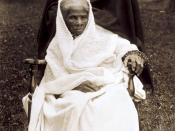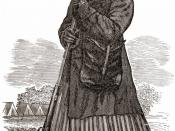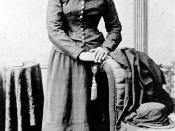Harriet Tubman:
The Icon of the Underground Railroad
In March 1913, Harriet Tubman was buried with military honors in Auburn's Fort Hill Cemetery. A photograph of the event shows a handsome coffin at the gravesite, while black and white mourners crowd around (Clinton 215). Shortly after her death, the town of Auburn, New York decided to dedicate a plaque in her honor. The bronze tablet meant to herald Tubman's achievement.
It began:
CALLED THE "MOSES" OF HER PEOPLE, DURING THE CIVIL WAR, WITH RARE COURAGE, SHE LED OVER THREE HUNDRED NEGROES UP FROM SLAVERY TO FREEDOM, AND RENDERED INVALUABLE SERVICE AS NURSE AND SPY.
It then proclaimed:
SHE TRUTHFULLY SAID "ON MY UNDERGROUND RAILROAD
I NEBBER RUN MY TRAIN OF DE TRACK AND I NEBBER LOS'
A PASSENGER." (Clinton 216)
Tubman had become a celebrity during her years with the Underground Railroad and her struggle for the freedom of blacks.
She came to be known by several names such as "Moses", in being the leader and guide to many in their exodus from the Land of Bondage, "Conductor of the Underground Railroad" and many more. The Underground Railroad, which was a passage to freedom for many slaves, was rife with dangers. The escape required both faith and courage. It is one of the most enduring and popular part of American history. (Clinton 215-217; Maxwell, Harriet Ross Tubman)
African-Americans in History
When we think of African Americans in history, what first comes to our mind is "slavery". Africans first came to America through the Atlantic slave trade, where blacks from along the coast of West Africa were transferred to European colonies in the Americas. From the time the first slaves came to Virginia in 1691, the Africans have played an important part in the American working class. The...


